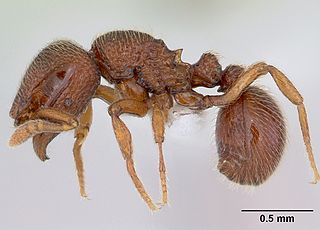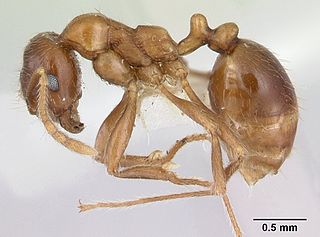
Myrmicinae is a subfamily of ants, with about 140 extant genera; their distribution is cosmopolitan. The pupae lack cocoons. Some species retain a functional sting. The petioles of Myrmicinae consist of two nodes. The nests are permanent and in soil, rotting wood, under stones, or in trees.

Diaphoromyrma is a genus of ants in the subfamily Myrmicinae. It contains the single species Diaphoromyrma sofiae, known only from workers from the type locality in Bahia, Brazil. The genus is apparently close to Allomerus and Diplomorium in the Solenopsidini, but its tribal attribution remains uncertain.

Manica is a genus of ants within the subfamily Myrmicinae. To date it contains six known species.

Agroecomyrmecinae is a subfamily of ants containing two extant and two fossil genera. The subfamily was originally classified in 1930 by Carpenter as Agroecomyrmecini, a Myrmicinae tribe. Bolton raised the tribe to subfamily status in 2003, suggesting that Agroecomyrmecinae might be the sister taxon to Myrmicinae. It has since been discovered to be one of the earliest lineages of ants, a clade from the basal polytomy for all ants. In 2014, the subfamily was expanded to two tribes. The tribe Ankylomyrmini was moved from the subfamily Myrmicinae to Agroemyrmecinae.

Baracidris is a genus of ants in the subfamily Myrmicinae. The genus is known from central and western Africa.

Mesostruma is a genus of ants in the subfamily Myrmicinae. It is restricted to Australia.

Microdaceton is an African genus of ants in the subfamily Myrmicinae. The genus consists of four species restricted to the Afrotropics. They nest in the leaf litter and seems to be fairly common. However, little is known about their biology.

Xenomyrmex is a genus of small ants in the subfamily Myrmicinae. The genus is known from Florida, the West Indies, and from Mexico to at least Panama. They nest in cavities of living or dead plants.
Meranoplus parviumgulatus is a species of ant in the genus Meranoplus. It is known from New Guinea and Papua New Guinea.

Terataner is an African genus of arboreal ants in the subfamily Myrmicinae.

Rotastruma is a small genus of arboreal ants in the subfamily Myrmicinae. Its two species are known from the Oriental region: the type species Rotastruma recava is known from the Bukit Timah Nature Reserve, Singapore, and Rotastruma stenoceps is known from Guangdong, China.

Calyptomyrmex is a genus of ants in the subfamily Myrmicinae. The genus is distributed from Africa to India and east to New Caledonia. They are mainly found in the rainforest, where they forage alone or in small numbers.

Indomyrma is an Asian genus of ants in the subfamily Myrmicinae. The genus contains two species: the type species Indomyrma dasypyx known from India and Indomyrma bellae known from Vietnam.

Dicroaspis is an African genus of ants in the subfamily Myrmicinae.

Lachnomyrmex is a Neotropical genus of ants in the subfamily Myrmicinae. The genus consists of 16 species restricted to the Neotropics, known from southern Mexico to northern Argentina. They are most often found in the leaf litter of wet forests, with nests located on the ground. Workers forage alone, apparently without recruiting nestmates or using pheromones. Within the tribe Stenammini, they seem to be most closely related to the genera Lordomyrma of Indo-Australia and Cyphoidris of Africa.

Bondroitia is a small genus of ants in the subfamily Myrmicinae. Its two species are known from Africa.

Ankylomyrma is a genus of large arboreal ants in the subfamily Agroecomyrmecinae. It contains the single species Ankylomyrma coronacantha, the sole member of the tribe Ankylomyrmini. The genus is known from Africa. Nothing is known about their biology. The genus was moved from the subfamily Myrmicinae to Agroecomyrmecinae in 2014.

Ocymyrmex is an African genus of ants in the subfamily Myrmicinae, also commonly known as hotrod ants.

Kartidris is an Indomalayan genus of terrestrial ants in the subfamily Myrmicinae. Its six species are known from mountainous areas in China, Thailand and India.

Paratopula is a genus of ants in the subfamily Myrmicinae. The genus consists of arboreal species known from the Oriental and Indo-Australian regions. Little is known about their biology.



















